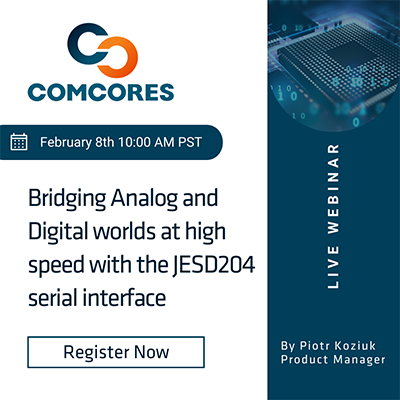To meet the increased demand for converter speed and resolution, JEDEC proposed the JESD204 standard describing a new efficient serial interface to handle data converters. In 2006, the JESD204 standard offered support for multiple data converters over a single lane with the following standard revisions; A, B, and C successively adding features such as support for multiple lanes, deterministic latency, and error detection and correction while constantly increasing Lane Rates. The JESD204D revision is currently in the works and aims to once more increase the Lane Rate to 112Gbps with the change of lane encoding and a switch of the error correction scheme to Reed-Solomon. Most of today’s high-speed converters make use of the JESD standard and the applications fall within but are not limited to Wireless, Telecom, Aerospace, Military, Imaging, and Medical, in essence anywhere a high-speed converter can be used.
The JESD204 standard is dedicated to the transmission of converter samples over serial interfaces. Its framing allows for mapping M converters of S samples each with a resolution of N bits, onto L lanes with a F octet sized frames that, in succession, form larger Multiframes or Extended Multiblock structures described by K or E parameters. These frames allow for various placement of samples in high- or low-density (HD) and for each sample to be accompanied by CS control bits within a sample container of N’ bits or at the end of a frame (CF). These symbols, describing the sample data and frame formatting, paired with the mapping rules dictated by the standard, allow to communicate a shared understanding of how the transmitted data should be mapped and interpreted by both parties engaging in the transmission.
The 8b10b encoding scheme of JESD204, JESD204A and JESD204B paired with Decision Feedback Equalizers (DFEs) may not work efficiently above 12.5Gbps as it may not offer adequate spectral richness, for this reason, and for better relative power efficiency 64b66b encoding was introduced in JESD204C targeting applications up to 32 Gbps. JESD204D that is following in its footsteps with even higher line rates planned up to 112Gbps utilizing PAM4 PHYs demands a new encoding to efficiently encapsulate the Reed Solomon Forward Error Correction (RS-FEC) 10-bit symbol-oriented mapping.
Deterministic latency introduced in JESD204B allows for the system to maintain constant system latency throughout reset, and power up cycles, as well as re-initialization events. This is accomplished in most cases by providing a system reference signal (SYSREF) that establishes a common timing reference between the Transmitter and Receiver and allows the system to compensate for any latency variability or uncertainty.
The main traps and pitfalls of system design around the JESD204 standard would deal with system clocking in subclass 1 where deterministic latency is achieved with the use of SYSREF as well as SYSREF generation and utilization under different system conditions. Choosing the right frame format and SYSREF type to match system clock stability and link latency can also prove challenging.
View the replay here: https://attendee.gotowebinar.com/recording/5500320533040852748
About Comcores
Comcores is a Key supplier of digital IP Cores and design services for digital subsystems with a focus on Ethernet Solutions, Wireless Fronthaul and [-RAN, and Chip to Chip Interfaces. Comcores’ mission is to provide best-in-class, state of the art, quality components and design services to ASIC, FPGA, and System vendors, and thereby drastically reduce their product cost, risk, and time to market. Our longterm background in building communication protocols, ASIC development, wireless networks and digital radio systems has brought a solid foundation for understanding the complex requirements of modern communication tasks. This know-how is used to define and build state-of-the-art, high-quality products used in communication networks.

Also Read:
Bridging Analog and Digital worlds at high speed with the JESD204 serial interface
CEO Interview: John Mortensen of Comcores
Share this post via:







Quantum Computing Technologies and Challenges